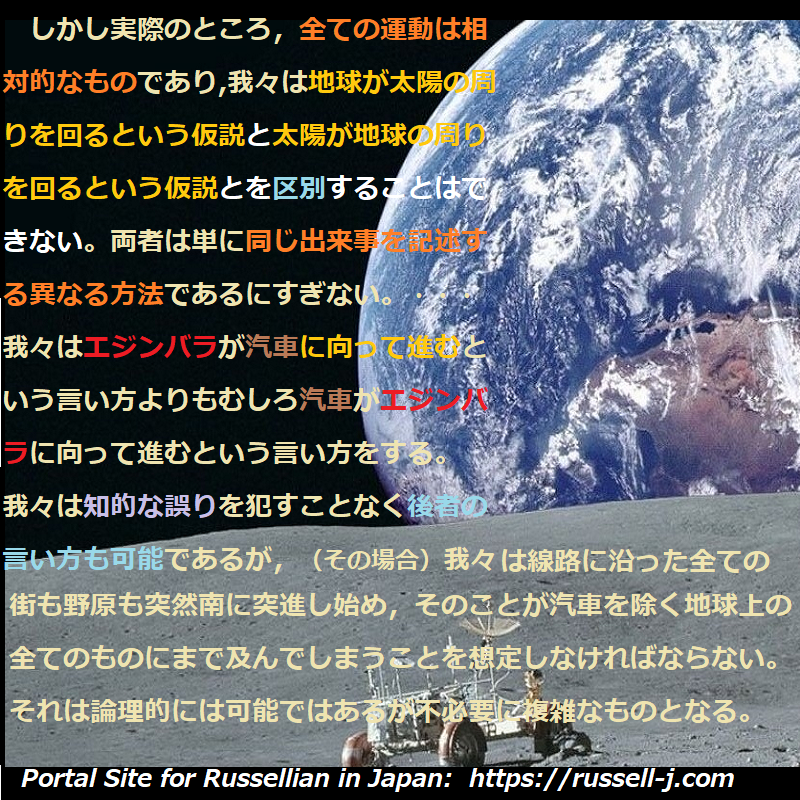
ケプラーの法則は,(ニュートンの)引力の法則とは異なり,純粋に記述的なものであった。(即ち)その法則は,惑星の運行(運動)の一般的原因については何も示唆せず,観察の結果を要約する最も単純な公式を与えた(のである)。記述の単純さは,それまで(so far その時まで),惑星が地球の周りを回るというよりも(惑星が)太陽の周りを回るという理論の唯一の利点であり,また,天界の見た目の回転(見たところ、天空は地球を中心にして回転しているように見えること)は実際は地球の回転のせいであるという理論の唯一の利点であった。17世紀の天文学者たちには,単純さ以上のものが関係しており,地球は実際に回転し,惑星は実際に太陽の周りを回っているように思われた。そうして,この見方(見解)はニュートンの研究によって補強された(のである)。しかし,実際のところ(は),全ての運動は相対的なものであり(注:相対性理論により明らか),我々は,地球が太陽の周りを回るという仮説と太陽が地球の周りを回るという仮説とを区別することはできない。両者は,単に,同じ出来事を記述する異なる方法であるにすぎない。たとえば,AがBと結婚するというかあるいはBがAと結婚するという場合と同じである(両方共同じことを言っている)。しかし,精密な計算をする時には(work out the details),コペルニクスによる記述のより大きな単純さはとても重要であり,正気な人なら誰も,地球が動かない(固定している)という考えの中に含まれている複雑さという荷物を自らに担がせるようなことはしないであろう。我々,エジンバラが汽車に向って進むという言い方よりも,むしろ汽車がエジンバラに向って進む(travel 旅する)という言い方をする。我々は,知的な誤りを犯すことなく後者の(エジンバラが進むという)言い方も可能であるが,しかし,(その場合)我々は,線路に沿った全ての街も野原も突然南に突進し始め,そのことが汽車を除く地球上の全てのものにまで及んでしまうことを想定しなければならない。それは論理的には可能ではあるが不必要に複雑なものとなる。等しく恣意的かつ無目的なのは,プトレマイオスの仮説(地動説)における星々の日々の回転であるが,それも同様に知的な誤りを犯していない点は同じである。けれども,ケプラーやガリレオ及び彼らの追従者たちにとって -彼らは運動の相対性を認識していなかったので- 論争となっているこの問題は,記述における一つの便宜上の問題ではなく,客観的な真理の問題と思われた。そうして,この誤りは,当時の天文学の進歩にとっては必要な刺戟であったように思われる。なぜなら,コペルニクス説(地動説)によって導入された単純化がなければ天体の状態を支配する法則は決して発見されなかったであろうからである。
Chapter 2: The Copernican Revolution, n.8 Kepler’s laws, unlike the law of gravitation, were purely descriptive. They did not suggest any general cause of the movements of the planets, but gave the simplest formulae by which to sum up the results of observation. Simplicity of description was, so far, the only advantage of the theory that the planets revolved about the sun rather than the earth, and that the apparent diurnal revolution of the heavens was really due to the earth’s rotation. To seventeenth-century astronomers it seemed that more than simplicity was involved, that the earth really rotates and the planets really go round the sun, and this view was reinforced by Newton’s work. But in fact, because all motion is relative, we cannot distinguish between the hypothesis that the earth goes round the sun and the hypothesis that the sun goes round the earth. The two are merely different ways of describing the same occurrence, like saying that A marries B or that B marries A. But when we come to work out the details, the greater simplicity of the Copernican description is so important that no sane person would burden himself with the complications involved in taking the earth as fixed. We say that a train travels to Edinburgh, rather than that Edinburgh travels to the train. We could say the latter without intellectual error, but we should have to suppose that all the towns and fields along the line suddenly took to rushing southward, and that this extends to everything on the earth except the train, which is logically possible but unnecessarily complicated. Equally arbitrary and purposeless is the diurnal revolution of the stars on the Ptolemaic hypothesis, but it is equally free from intellectual error. To Kepler and Galileo and their opponents, however, since they did not recognize the relativity of motion, the question in debate appeared to be not one of convenience in description, but of objective truth. And this mistake was, it would seem, a necessary stimulus to the progress of astronomical science at that time, since the laws governing the conditions of the heavenly bodies would never have been discovered but for the simplifications which were introduced by the Copernican hypothesis.
出典:Religion and Science, 1935, chapt. 2.
情報源:https://russell-j.com/beginner/RS1935_02-080.HTM
